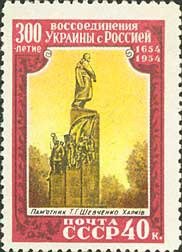Stamp: The monument to Taras Shevchenko in Kharkiv (Soviet Union, USSR 1954)
The monument to Taras Shevchenko in Kharkiv (Soviet Union, USSR 1954)
10 May (Soviet Union, USSR ) within release Anniversaries goes into circulation Stamp The monument to Taras Shevchenko in Kharkiv face value 40 Russian kopek
| Stamp The monument to Taras Shevchenko in Kharkiv in catalogues | |
|---|---|
| Michel: | Mi:SU 1703 |
Stamp is square format.
Also in the issue Anniversaries:
- Stamp - Buildings of Supreme Soviets of Ukrainian SSR and RSFSR face value 40;
- Stamp - The monument to Taras Shevchenko in Kharkiv face value 40;
- Stamp - Kiev State University named after Taras Shevchenko face value 40;
- Stamp - Equestrian monument of Bogdan Khmelnitsky in Kiev face value 60;
- Stamp - Flags of Ukrainian SSR and Russian SFSR face value 1;
- Stamp - The Council of Pereyaslav in 1654 face value 1;
- Stamp - Order of Bogdan Khmelnitsky + Jubilee Overprint face value 2;
Stamp The monument to Taras Shevchenko in Kharkiv it reflects the thematic directions:
Sculpture is the branch of the visual arts that operates in three dimensions. Sculpture is the three-dimensional art work which is physically presented in the dimensions of height, width and depth. It is one of the plastic arts. Durable sculptural processes originally used carving (the removal of material) and modelling (the addition of material, as clay), in stone, metal, ceramics, wood and other materials but, since Modernism, there has been almost complete freedom of materials and process. A wide variety of materials may be worked by removal such as carving, assembled by welding or modelling, or moulded or cast.
A monument is a type of structure that was explicitly created to commemorate a person or event, or which has become relevant to a social group as a part of their remembrance of historic times or cultural heritage, due to its artistic, historical, political, technical or architectural importance. Examples of monuments include statues, (war) memorials, historical buildings, archaeological sites, and cultural assets. If there is a public interest in its preservation, a monument can for example be listed as a UNESCO World Heritage Site. The Palgrave Encyclopedia of Cultural Heritage and Conflict gives the next definition of monument:
An anniversary is the date on which an event took place or an institution was founded in a previous year, and may also refer to the commemoration or celebration of that event. For example, the first event is the initial occurrence or, if planned, the inaugural of the event. One year later would be the first anniversary of that event. The word was first used for Catholic feasts to commemorate saints. Most countries celebrate national anniversaries, typically called national days. These could be the date of independence of the nation or the adoption of a new constitution or form of government. The important dates in a sitting monarch's reign may also be commemorated, an event often referred to as a "Jubilee".


